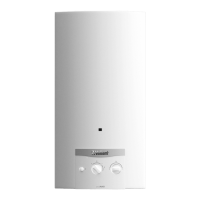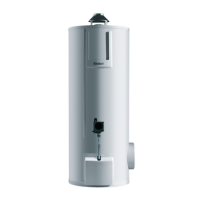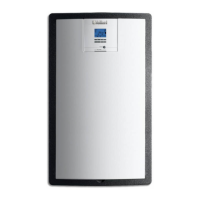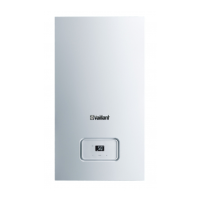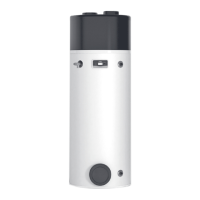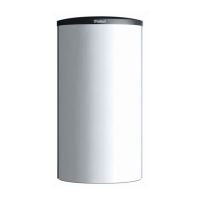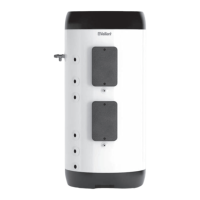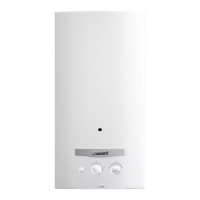
Do you have a question about the Vaillant atmoMAG MAG mini 114/1 I and is the answer not in the manual?
| Gas Type | Natural Gas |
|---|---|
| Ignition | Piezo ignition |
| Nominal Heat Input | 19.2 kW |
| Nominal Heat Output | 17.4 kW |
| Minimum Water Pressure | 0.15 bar |
| Maximum Water Pressure | 10 bar |
| Flue Diameter | 110 mm |
| Gas Connection | 1/2 inch |
| Water Connection | 1/2 inch |
| Hot Water Production | 11 L/min |
Classification of warnings, signal words and their meanings for immediate danger.
Defines the product's intended application and restrictions, including fixed installations.
Covers risks related to qualifications, flue gas, poisoning, air supply, corrosion, gas leaks, frost, safety devices, and hot components.
Warns about explosion risks from liquid gas accumulation if installed below ground.
Advises using the correct tools for maintenance and installation.
Emphasizes observing all national and international regulations, laws, and standards.
Stresses the need to observe all system component operating and installation instructions.
Instructs to pass instructions and documents to the system operator for safekeeping.
Describes the location and content of the product's data plate.
Illustrates and labels the main components of the product for identification.
Details steps to check if the product and accessories are complete and intact upon arrival.
Provides diagrams and instructions for wall mounting and connection points.
Illustrates and specifies required clearances around the product for installation.
Presents detailed dimensional drawings of the product and a height table for different regions.
Outlines criteria for selecting a suitable installation location, considering pipe routing and wall material.
Illustrates the procedure for removing the product's outer casing.
Illustrates the procedure for refitting the product's outer casing.
Details the steps for securely mounting the product to the wall, including checking load capacity.
Explains product settings for liquid gas and natural gas conversion requirements.
Warns about potential faults and noise from using the incorrect gas type.
Lists the order for connecting water and gas lines, including descaling and flushing.
Covers gas pipe installation, connection, and leak-tightness checks according to rules.
Illustrates and describes how to connect the flue pipe to the product's down-draught diverter.
States that initial start-up must be by a qualified technician using a commissioning checklist.
Explains how to measure and adjust the water flow rate using a micro switch.
Describes how the flue gas sensor prevents operation if the flue system is blocked.
Details the procedure for checking gas flow pressure using a manometer.
Advises checking gas pipes and hot water circuits for leaks.
Outlines essential explanations and information to provide to the end user regarding safety and operation.
Explains how LED indicators display faults and how to use the appendix to resolve them.
Describes how to reset the product and perform functional checks for faults.
Recommends using original spare parts for safe operation and avoiding conformity issues.
Lists sequential steps to remove the burner assembly from the product.
Provides instructions for cleaning the burner, jets, and injectors using brushes.
Details checking the injector rail for dirt and damage, emphasizing not removing burner jets.
Illustrates and describes the steps to remove the down-draught diverter.
Explains how to clean the down-draught diverter with water and brush.
Provides a caution and sequence for removing the heat exchanger to prevent damage.
Details methods for cleaning the heat exchanger fins using water, brush, and descaler.
Describes checking the cold water strainer and water valve for tightness.
Explains two methods (volumetric and burner pressure) to check the heat input.
Details how to adjust the maximum heat input using the adjusting screw and manometer.
Provides instructions and warnings for replacing the product's battery.
Lists final steps after maintenance, including reassembly, testing, and logging.
Outlines steps to safely shut down and drain the product.
Advises correct disposal of packaging and adherence to relevant regulations.
Lists procedures, comments, and required tools for product commissioning.
Provides a table of symptoms, possible causes, and measures for troubleshooting common issues.
Presents data on factory gas settings, gas flow, and burner pressure for different gas types.
Illustrates the product's internal wiring connections with numbered components.
Lists recommended intervals for various inspection and maintenance tasks.
Lists general technical specifications like dimensions, connection sizes, and weight.
Details power and load specifications, including heat input, output, and water volumes.
Provides specific technical data for liquid gas (G31) operation.
